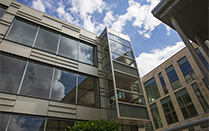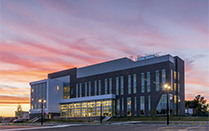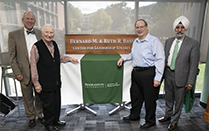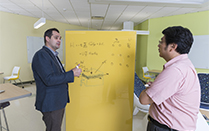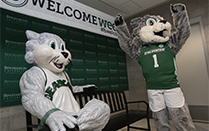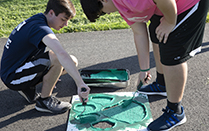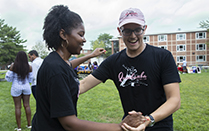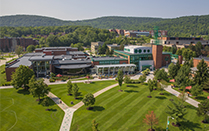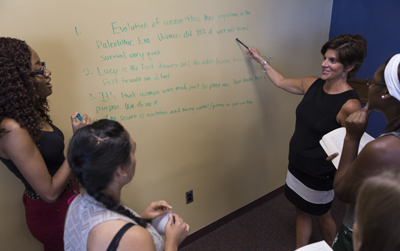
The Learning Studio
The technology rich Learning Studio in the Center for Learning and Teaching (CLT) – nicknamed “The Sandbox” – is one version of the classroom of the future according to James Pitarresi, CLT executive director.
The Learning Studio, which accommodates 28 students, is set up with soft seating and small tables up front to be very collaborative and to encourage active learning. It also features four large, wirelessly programmable screens and walls that you can write on.
“The whole idea behind this space came out of a conversation I had with [Provost] Don Nieman when we talked about enhancing teaching and he wanted something in the center of campus – a space where faculty could experiment with different teaching styles and such,” said Pitarresi. “A teaching laboratory.”
And that’s how the space is being used this semester, with seven classes ranging from freshman engineering to graduate-level English being taught there. “We know that active engagement with the material is the best way for students to learn and feel this emphasizes and encourages active engagement,” Pitarresi said.
“We’re bringing in the students and faculty, they’re playing with the layout of the room, the interaction of the space and what type of pedagogy is best suited to their courses. Will it scale up? We don’t know, but this will help us fine tune the pedagogy.”
The challenge is gateway courses, Pitarresi said. “If we know that active engagement with material is the best way for students to learn, given our infrastructure, how do we find the intersection given the physical constraints we have? Can lecture halls be redesigned to take advantage as much as possible of the things we learn here?”
The large-screen technology in the Learning Studio allows any device to connect to any screen in any combination, and the instructor has control over who’s presenting what and where. “We’re starting to explore this now,” said Pitarresi. “Teams of students can be given permission to use one screen, then the instructor can pull the screen the team is using up to all of the screens.
“What’s exciting about this is we’re not afraid to fail,” said Pitarresi. “We’ll put things in here and we might say, ‘What were we thinking?’ So we’re experimenting.”
These seven instructors are real trailblazers, he said, many learning the technology for the first time and working with our instructional designers to learn about new teaching techniques.
The biggest thing we did was hire instructional designers, said Pitarresi. “They can say, ‘Here are five best practices for what we want to do.’ It’s a huge step forward for us.”
Pitarresi hopes to move into the realm of digital fluency, with the Learning Studio as a start. “The big, broad stroke is the concept of digital fluency,” he said. “Our students are great at digital consumption. But are they great at digital production? E-portfolios, being able to build a good Skype presentation for a job interview, the ability to organize an effective Webinar, capstone projects?
“This is an opportunity for us to distinguish ourselves through an ability to understand and utilize digital media. How do you promote yourself digitally? This is part of where digital fluency could go,” he added.
One other aspect of the Learning Studio is the research that Pitarresi hopes to come from its use. Working with Herman Miller Furniture, a research study is under way.
“We had a competitive bidding process and now Herman Miller has gotten involved. Their research group is looking at 30 universities doing similar things and the goal is two-fold. What works here at Binghamton with our model, but also to develop some scholarship on the intersection of people, pedagogy and place. We’re asking basic questions.”
For example, Sharon Fellows is teaching two sections of a course in a traditional classroom – one with a random group of students and the other with students from the Engineering Learning Community and one in the Learning Studio. “Which section will do better?” Pitarresi asked. “Can simply putting in furniture and paint make a difference? We’re going to find out and plan to publish our results. We’re actually working on the infrastructure and technology in the classroom with an eye toward scholarship, which I think is the proper role of this institution and that’s exciting.”
